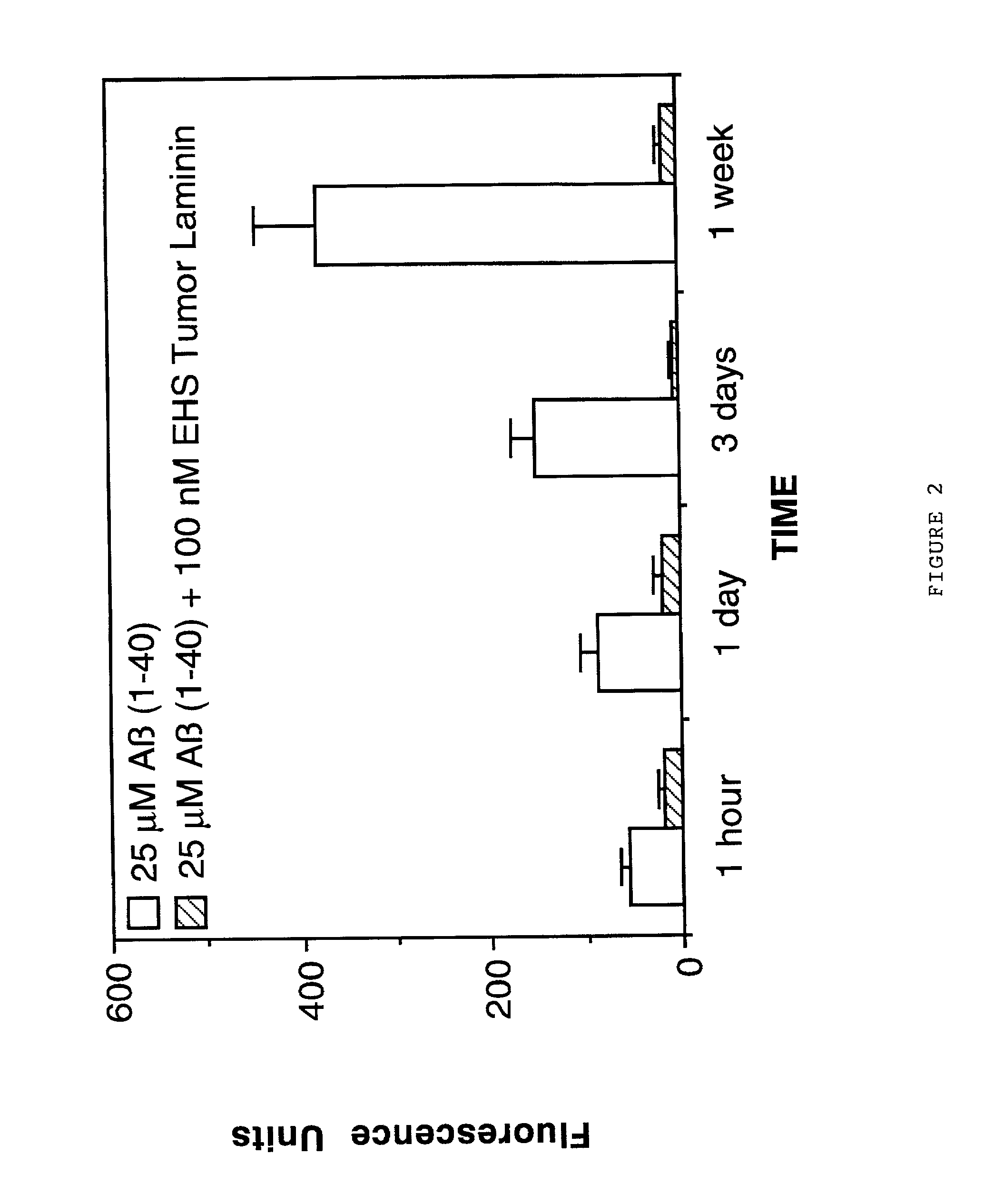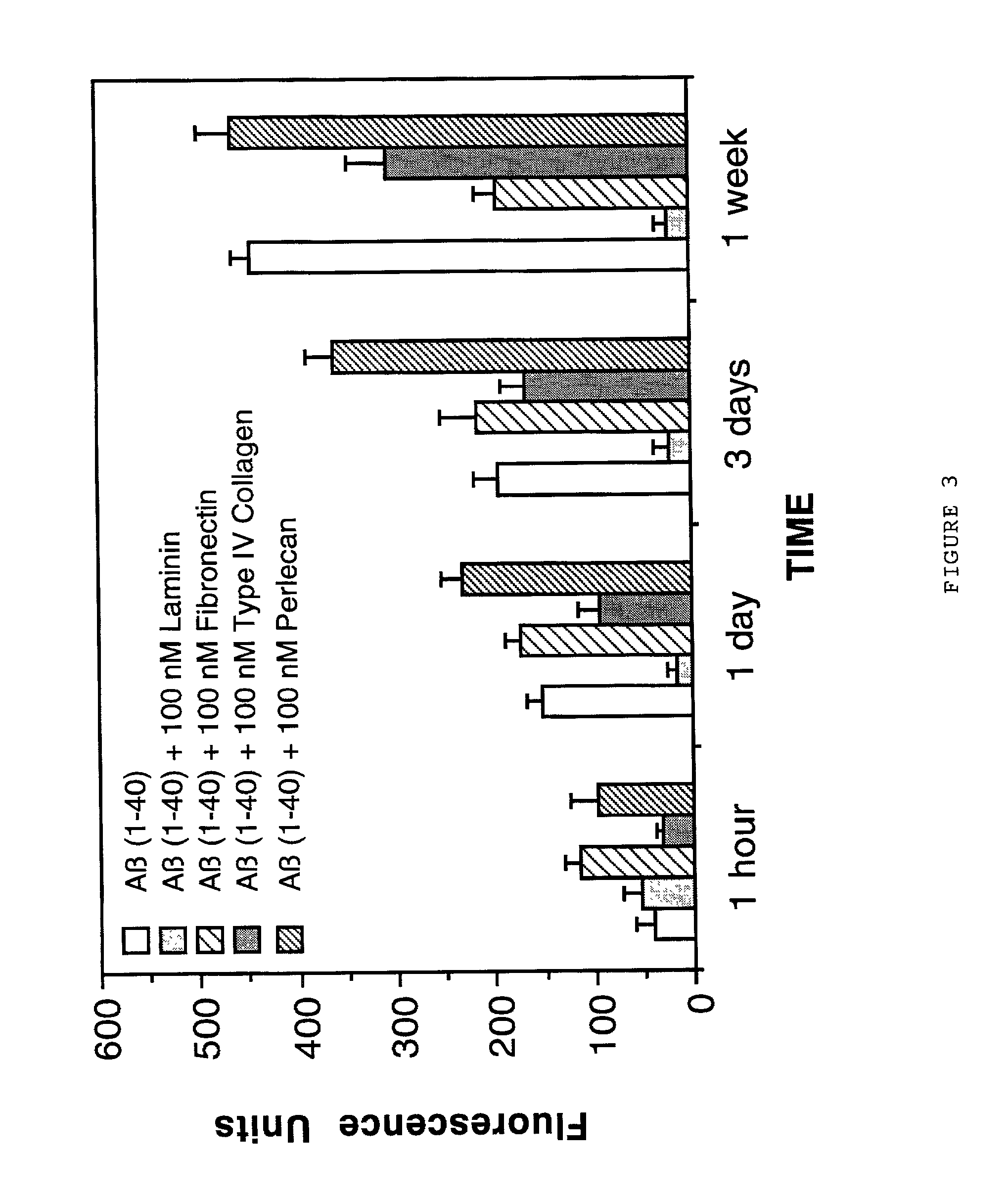Therapeutic applications of laminin and laminin-derived protein fragments
a technology of laminin and laminin-derived protein, applied in the field of amyloid disease diagnostic applications, can solve the problems of toxicity and neuronal cell death, and the fact that this potential fibrillar protein remains soluble in circulating biological fluids, and achieve the effect of inhibiting amyloid deposition and inhibiting amyloidosis
- Summary
- Abstract
- Description
- Claims
- Application Information
AI Technical Summary
Benefits of technology
Problems solved by technology
Method used
Image
Examples
example 1
Binding of Laminin to the Beta-Amyloid Protein (A.beta.) of Alzheimer's Disease
[0076] 2 .mu.g of A.beta. (1-40)(Bachem Inc., Torrance, Calif. USA; Lot #WM365) in 40 .mu.l of Tris-buffered saline (TBS)(pH 7.0) was allowed to bind overnight at 4.degree. C. to microtiter wells (Nunc plates, Maxisorb). The next day all of the microtiter wells were blocked by incubating with 300 .mu.l of Tris-buffered saline containing 100 mM Tris-HCl, 50 MM NaCl, 0.05% Tween-20, and 3 mM NaN.sub.3 (pH 7.4)(TTBS) plus 2% bovine serum albumin (BSA). Various dilutions (ie. 1:10, 1:30, 1:90, 1:270, 1:810, 1:2430 and 1:7290) of Engelbreth-Holm-Swarm (EHS) mouse tumor laminin (1 mg / ml)(Sigma Chemical Co., St. Louis, Mo., USA) in 250 .mu.l of TBS (pH 7.4) were placed in wells (in triplicate) either containing substrate bound A.beta. (1-40) or blank, and allowed to bind overnight at 40.degree. C. overnight. The next day, the wells were rinsed 3 times with TTBS, and then probed for 2 hours with 100 .mu.l of rabb...
example 2
Inhibition of Alzheimer's Disease A.beta. Fibril Formation by Laminin
[0080] The effects of laminin on A.beta. fibrillogenesis was also determined using the previously described method of Thioflavin T fluorometry (Naiki et al, Lab. Invest. 65:104-110, 1991; Levine III, Protein Sci. 2:404-410, 1993; Levine III, Int. J. Exp. Clin. Invest. 2:1-6, 1995; Naiki and Nakakuki, Lab. Invest. 74:374-383, 1996). In this assay, Thioflavin T binds specifically to fibrillar amyloid and this binding produces a fluorescence enhancement at 480 nm that is directly proportional to the amount of amyloid fibrils formed (Naiki et al, Lab. Invest. 65:104-110, 1991; Levine III, Protein Sci. 2:404-410, 1993; Levine III, Int. J. Exp. Clin. Invest. 2:1-6, 1995; Naiki and Nakakuki, Lab. Invest. 74:374-383, 1996). In a first study, the effects of EHS laminin on A.beta. (1-40) fibrillogenesis was assessed. For this study, 25 .mu.M of freshly solubilized A.beta. (1-40)(Bachem Inc., Torrance, Calif., USA; Lot #WM365...
example 3
Laminin Causes Dose-Dependent Dissolution of Pre-Formed Alzheimer's Disease Amyloid Fibrils
[0085] The next study was implemented to determine whether laminin was capable of causing a dose-dependent dissolution of pre-formed Alzheimer's disease A.beta. (1-40) amyloid fibrils. This type of activity would be important for any potential anti-Alzheimer's amyloid drug which can be used in patients who already have substantial amyloid deposition in brain. For example, Alzheimer's disease patients in mid-to late stage disease have abundant amyloid deposits in their brains as part of both neuritic plaques and cerebrovascular amyloid deposits. A therapeutic agent capable of causing dissolution of pre-existing amyloid would be advantageous for use in these patients who are at latter stages of the disease process.
[0086] For this study, 1 mg of A.beta. (1-40)(Bachem Inc., Torrance, Calif., USA; Lot #WM365) was dissolved in 1.0 ml of double distilled water (1 mg / ml solution) and then incubated at...
PUM
| Property | Measurement | Unit |
|---|---|---|
| body weight | aaaaa | aaaaa |
| body weight | aaaaa | aaaaa |
| diameter | aaaaa | aaaaa |
Abstract
Description
Claims
Application Information
 Login to View More
Login to View More - R&D
- Intellectual Property
- Life Sciences
- Materials
- Tech Scout
- Unparalleled Data Quality
- Higher Quality Content
- 60% Fewer Hallucinations
Browse by: Latest US Patents, China's latest patents, Technical Efficacy Thesaurus, Application Domain, Technology Topic, Popular Technical Reports.
© 2025 PatSnap. All rights reserved.Legal|Privacy policy|Modern Slavery Act Transparency Statement|Sitemap|About US| Contact US: help@patsnap.com



